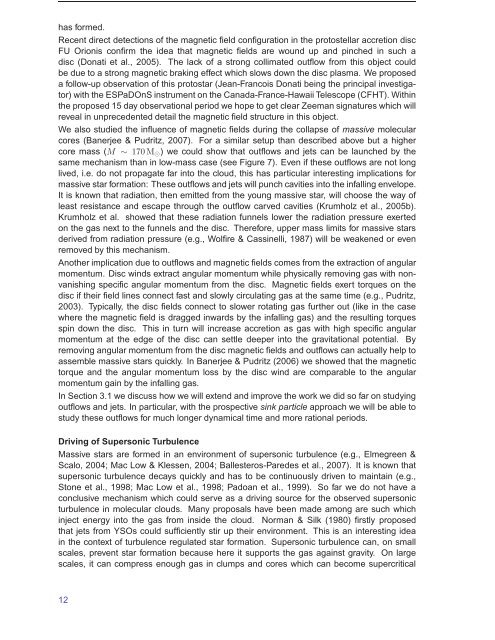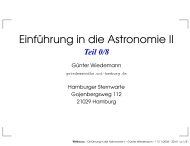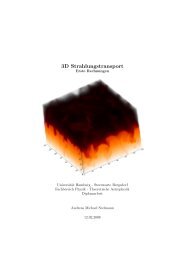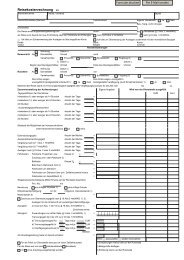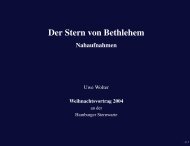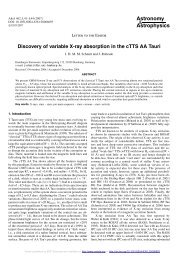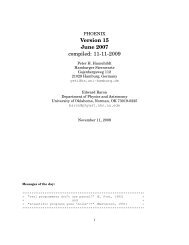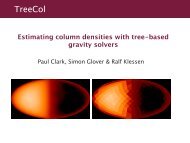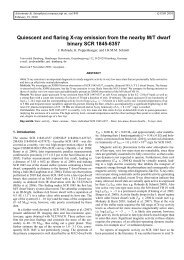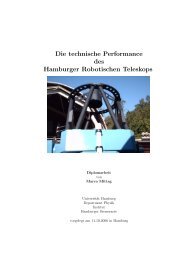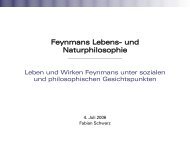Emmy Noether Application
Emmy Noether Application
Emmy Noether Application
You also want an ePaper? Increase the reach of your titles
YUMPU automatically turns print PDFs into web optimized ePapers that Google loves.
has formed.<br />
Recent direct detections of the magnetic field configuration in the protostellar accretion disc<br />
FU Orionis confirm the idea that magnetic fields are wound up and pinched in such a<br />
disc (Donati et al., 2005). The lack of a strong collimated outflow from this object could<br />
be due to a strong magnetic braking effect which slows down the disc plasma. We proposed<br />
a follow-up observation of this protostar (Jean-Francois Donati being the principal investigator)<br />
with the ESPaDOnS instrument on the Canada-France-Hawaii Telescope (CFHT). Within<br />
the proposed 15 day observational period we hope to get clear Zeeman signatures which will<br />
reveal in unprecedented detail the magnetic field structure in this object.<br />
We also studied the influence of magnetic fields during the collapse of massive molecular<br />
cores (Banerjee & Pudritz, 2007). For a similar setup than described above but a higher<br />
core mass (M ∼ 170M⊙) we could show that outflows and jets can be launched by the<br />
same mechanism than in low-mass case (see Figure 7). Even if these outflows are not long<br />
lived, i.e. do not propagate far into the cloud, this has particular interesting implications for<br />
massive star formation: These outflows and jets will punch cavities into the infalling envelope.<br />
It is known that radiation, then emitted from the young massive star, will choose the way of<br />
least resistance and escape through the outflow carved cavities (Krumholz et al., 2005b).<br />
Krumholz et al. showed that these radiation funnels lower the radiation pressure exerted<br />
on the gas next to the funnels and the disc. Therefore, upper mass limits for massive stars<br />
derived from radiation pressure (e.g., Wolfire & Cassinelli, 1987) will be weakened or even<br />
removed by this mechanism.<br />
Another implication due to outflows and magnetic fields comes from the extraction of angular<br />
momentum. Disc winds extract angular momentum while physically removing gas with nonvanishing<br />
specific angular momentum from the disc. Magnetic fields exert torques on the<br />
disc if their field lines connect fast and slowly circulating gas at the same time (e.g., Pudritz,<br />
2003). Typically, the disc fields connect to slower rotating gas further out (like in the case<br />
where the magnetic field is dragged inwards by the infalling gas) and the resulting torques<br />
spin down the disc. This in turn will increase accretion as gas with high specific angular<br />
momentum at the edge of the disc can settle deeper into the gravitational potential. By<br />
removing angular momentum from the disc magnetic fields and outflows can actually help to<br />
assemble massive stars quickly. In Banerjee & Pudritz (2006) we showed that the magnetic<br />
torque and the angular momentum loss by the disc wind are comparable to the angular<br />
momentum gain by the infalling gas.<br />
In Section 3.1 we discuss how we will extend and improve the work we did so far on studying<br />
outflows and jets. In particular, with the prospective sink particle approach we will be able to<br />
study these outflows for much longer dynamical time and more rational periods.<br />
Driving of Supersonic Turbulence<br />
Massive stars are formed in an environment of supersonic turbulence (e.g., Elmegreen &<br />
Scalo, 2004; Mac Low & Klessen, 2004; Ballesteros-Paredes et al., 2007). It is known that<br />
supersonic turbulence decays quickly and has to be continuously driven to maintain (e.g.,<br />
Stone et al., 1998; Mac Low et al., 1998; Padoan et al., 1999). So far we do not have a<br />
conclusive mechanism which could serve as a driving source for the observed supersonic<br />
turbulence in molecular clouds. Many proposals have been made among are such which<br />
inject energy into the gas from inside the cloud. Norman & Silk (1980) firstly proposed<br />
that jets from YSOs could sufficiently stir up their environment. This is an interesting idea<br />
in the context of turbulence regulated star formation. Supersonic turbulence can, on small<br />
scales, prevent star formation because here it supports the gas against gravity. On large<br />
scales, it can compress enough gas in clumps and cores which can become supercritical<br />
12


